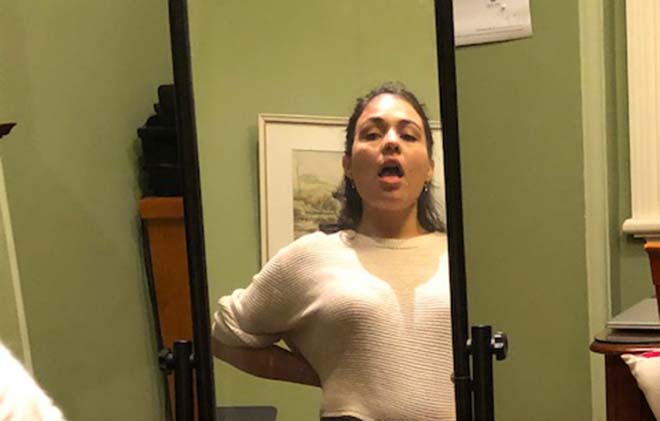Breath control: the best support act for your singing growth
While breathing in our daily lives is something our bodies do automatically, breathing for singing is something we have to learn.
But learning proper breath support can take a while, because your body has to learn new ways to be and breathe. It can be complex, challenging and thought provoking – but it’s vital if you want your voice to produce smooth, pleasing, sustainable sound.
WHAT IS SUPPORTED BREATHING FOR SINGING?
Simply put, the process involves your diaphragm (a thin muscle between chest and belly) descending naturally on a long in-breath, then ascending as you control your outbreath, by consciously contracting your abdominal muscles as you sing, giving you a steady flow of sound. It’s also known as breath control and breath management.
This approach to supported breathing has been used for more than 100 years and is known as appoggio. It’s an Italian term meaning to lean against. I think of it as finding a balance of forces (your abdominal muscles and flow of air), that efficiently coordinates breathing and in turn, produces the necessary breath pressure and air flow for skilled singing.
WHY DO YOU NEED BREATH SUPPORT TO SING WELL?
To prevent running out of air on a note or phrase. Good posture is vitally important for this. Without it, on your inhale and exhale, you will lose breath and limit your capacity to sing a note over a long or even short time. Try yoga, Pilates or Alexander Technique to help you deeply understand your body’s unique postural structures, improve your movement – and your sound.
Use more of your vocal range. As you learn to control the outflow of your breath, you’ll gradually access your full singing range, especially those exciting high notes and even the warm, rich low and middle registers. Your singing becomes more textured and pleasing to the ear.
Prevent vocal damage. When you use a belt voice in certain repertoire, you especially need a supported breath flow for healthy singing, and to avoid irreversible voice problems in future.
Shift through register changes easier. Learning to sustain, flow or support your breath lets you change between voice registers more smoothly. By using your abdominal muscles as you sing a note, you can also increase and decrease volume, otherwise known as ‘dynamics’.
 HOW DO SINGERS SUSTAIN A SMOOTH FLOW OF SOUND?
HOW DO SINGERS SUSTAIN A SMOOTH FLOW OF SOUND?
Sustaining a given note with your voice requires the interaction of muscle movement, bones – and your own desire to sing freely!
To support or flow sound, you need to learn how to contract your abdominal muscles towards the spine. Think of when you laugh or sneeze: you actively use your lower abdominals this same way. In singing training, you learn to use these muscles in a more managed, conscious manner to produce the sound needed, for the duration needed.
Start with a long spine, flexible abdominals, an open throat, shoulders down and back (not excessively) and gently, consciously, move your belly wall back to your spine as you sing.
In my experience as a singing teacher, and especially if you’re new to singing, you’ll need to choose your song repertoire carefully so you don’t place too many demands on your breathing capacity, voice and body before learning proper breath support and control. It’s one reason I prioritise breathing exercises in my singing lessons.
To get a better idea of how singers use breath support to produce sustained air flow for a smooth sound, watch these videos:
US stage actor and singer, Laura Benanti
British stage actor/singer, Matthew Stuart Price
Listen to Australian singer-songwriter, Katie Noonan , as she uses gentle muscle contraction to move her breath, giving her easy access to upper notes and added improvisation. Listen for the sustained and lengthen sound flow via her open throat.
THESE EXERCISES CAN HELP YOU DEVELOP YOUR BREATH CONTROL FOR BEAUTIFUL SINGING
‘Happy Birthday’: This beginner, yet staple exercise I use with my singing students trains your breath support and reminds you of the vital role your abdominal muscles play in sustaining your sound flow.
If you know the tune and the four distinct phrases, for ‘Happy Birthday’, you can do this exercise.
- On a flowing ‘zzz’ sound, sing the tune (in any key). Relax your jaw and just let the air flow. For any repeated notes just sing the one note. ‘Zzz’ means the tip of your tongue is curled toward and stays near the ridge behind your top teeth.
- Try the first two phrases initially to get the hang of the ‘zzz’, with your jaw as relaxed as possible. Keep your air flowing and notice if your abdominals slowly move toward your spine. Then try it for all four phrases.
- Sing the tune again and be aware of how you use your abdominals, moving them toward your spine to flow the air for each phrase. Was the sound flow smooth and connected? Or a bit disjointed or jerky?
- Do the song again and notice if your abdominals are connected or engaged as you sing ‘zzz’. Then release these muscles each time you take a breath for the next phrase.
 Try this exercise regularly. You can also use vowels such as ‘oo’ or ‘ah’ once you are accustomed to using your belly muscles to flow the air.
Try this exercise regularly. You can also use vowels such as ‘oo’ or ‘ah’ once you are accustomed to using your belly muscles to flow the air.
Lip and tongue trills are another way you learn to keep your breath flow even, and to extend the flow, without tensing neck, jaw and facial muscles. A singing teacher can help you with these.
Learning how to support breath flow for singing is a major part of your singing training and worth spending time on, so you can sing with finesse, clarity and enjoyment for yourself and your listeners.
Get the right foundations in correct breath support for singing with an expert vocal coach. Find out how Kathleen Connell can help.



